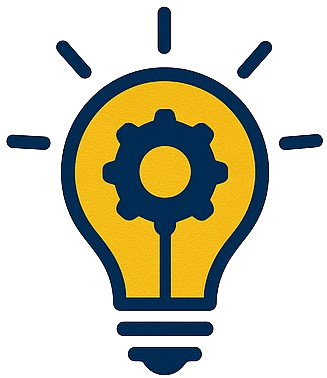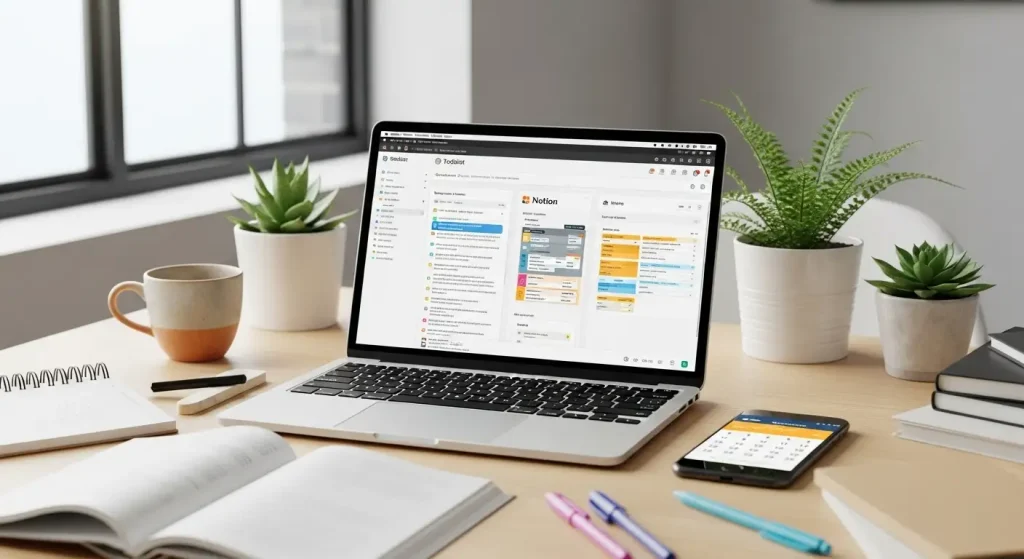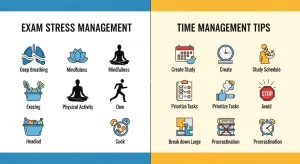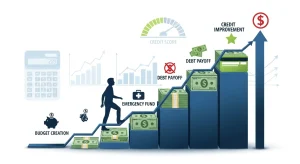In today’s fast-paced digital world, staying organized and productive is crucial for both academic success and professional growth. Fortunately, there are numerous free productivity apps available that can transform how students and professionals manage their time, tasks, and projects. Whether you’re juggling coursework, managing deadlines, or collaborating on team projects, the right productivity tools can make all the difference in achieving your goals.
Recent surveys show that the best productivity apps for students focus on task management, collaboration, and organization, making these digital solutions essential for modern learners and working professionals alike.
How to Build a Capsule Wardrobe on a Budget
Why Free Productivity Apps Are Essential in 2025
The demand for efficient productivity apps for students and professionals has skyrocketed as remote learning and hybrid work environments become the norm. Time management is not only an essential skill to succeed academically, but it also allows you to make time for other interests, making these tools invaluable for work-life balance.
Key Benefits of Using Productivity Apps:
- Improved time management and organization
- Enhanced collaboration capabilities
- Reduced stress through better planning
- Increased focus and efficiency
- Seamless synchronization across devices
- Cost-effective solutions for tight budgets
Best Free Productivity Apps for Task Management
1. Todoist: The Ultimate Task Organizer
Todoist stands out among free productivity apps with its intuitive interface and powerful organizational features. This task management app allows users to create projects, set deadlines, and collaborate with team members effortlessly.
Key Features:
- Natural language processing for quick task entry
- Project templates for recurring workflows
- Karma system for motivation and progress tracking
- Integration with popular calendar and email apps
- Offline functionality for uninterrupted productivity
2. ClickUp: Comprehensive Project Management
ClickUp for Students is like having a personal assistant, project manager, and productivity guru all rolled into one, making it an exceptional choice among productivity tools for both individual and team use.
Standout Benefits:
- Multiple project views (list, board, calendar, Gantt)
- Time tracking capabilities
- Document storage and collaboration
- Goal setting and progress monitoring
- Customizable workflows for different needs
3. Trello: Visual Project Organization
Trello’s Kanban board system makes it perfect for people who think visually, offering one of the most user-friendly experiences among best productivity apps.
Why Students and Professionals Love Trello:
- Drag-and-drop card system
- Board templates for various use cases
- Team collaboration features
- Power-ups for enhanced functionality
- Mobile apps for on-the-go management
10 Essential Cybersecurity Practices for Small Businesses
Top Free Apps for Note-Taking and Study Management
4. Notion: All-in-One Workspace
Notion has revolutionized how students and professionals organize information, combining note-taking, databases, and project management in one platform.
Powerful Features:
- Customizable templates for any workflow
- Database functionality for complex organization
- Real-time collaboration capabilities
- Web clipper for research collection
- Formula and calculation support
5. Evernote: Digital Note Repository
Evernote is the top choice for capturing, organizing, and retrieving notes across various formats, making it indispensable among free productivity apps for knowledge workers.
Core Advantages:
- Powerful search functionality across all notes
- Document scanning with OCR technology
- Cross-platform synchronization
- Web clipper for research collection
- Offline access to essential notes
6. Google Keep: Simple and Effective
For users seeking simplicity among productivity apps for students, Google Keep offers straightforward note-taking with excellent integration across Google’s ecosystem.
Key Benefits:
- Voice-to-text note creation
- Image notes with text recognition
- Location-based reminders
- Color-coded organization system
- Seamless Google Workspace integration
10 Easy Weekend DIY Home Projects to Upgrade Your Space
Essential Time Management and Focus Apps
7. Forest: Gamified Focus Sessions
Forest transforms productivity into a game, helping users maintain focus while building virtual forests. This unique approach makes it one of the most engaging student apps available.
Innovative Features:
- Pomodoro timer with gamification
- Real tree planting partnerships
- Social accountability features
- Detailed focus statistics
- Customizable focus session lengths
8. Toggl Track: Professional Time Tracking
For professionals and students who need to track time spent on various projects, Toggl Track offers comprehensive time management capabilities.
Professional Benefits:
- One-click time tracking
- Detailed reporting and analytics
- Project and client organization
- Team collaboration features
- Integration with popular work tools
10 Most-Anticipated TV Shows of 2025: Must-Watch Series Coming This Year
Collaboration and Communication Tools
9. Slack: Team Communication Hub
While primarily designed for professional teams, Slack’s free tier offers excellent features for study groups and collaborative projects.
Collaboration Features:
- Organized channel system
- File sharing and integration
- Video calling capabilities
- Message search functionality
- App integrations for enhanced workflow
10. Discord: Community-Driven Communication
Originally designed for gaming communities, Discord has become popular among productivity apps for students for study groups and project collaboration.
Student-Friendly Benefits:
- Voice and video chat rooms
- Screen sharing capabilities
- Text channels for organized discussions
- File sharing and collaboration
- Community server templates
Calendar and Scheduling Solutions
11. Google Calendar: Universal Scheduling
Google Calendar helps the minimalists who live by the calendar, offering robust scheduling features that integrate seamlessly with other productivity tools.
Essential Features:
- Multiple calendar support
- Smart scheduling suggestions
- Goal tracking integration
- Event templates and recurring events
- Cross-platform accessibility
12. Calendly: Automated Meeting Scheduling
For professionals who frequently schedule meetings, Calendly eliminates the back-and-forth of finding suitable meeting times.
Professional Advantages:
- Automated scheduling based on availability
- Integration with major calendar platforms
- Customizable meeting types and durations
- Time zone detection and conversion
- Meeting preparation workflows
10 Most-Anticipated Movies of 2025
How to Choose the Right Productivity Apps for Your Needs
Selecting the best productivity apps depends on your specific requirements, workflow preferences, and collaboration needs. Consider these factors when evaluating options:
For Students:
- Academic focus: Apps that support research, note-taking, and assignment tracking
- Budget considerations: Free tiers that offer substantial functionality
- Collaboration needs: Tools that facilitate group projects and study sessions
- Device compatibility: Apps that work across laptops, tablets, and smartphones
For Professionals:
- Industry requirements: Tools that integrate with existing business software
- Team collaboration: Robust sharing and communication features
- Time tracking: Capability to monitor productivity and billable hours
- Security features: Data protection and privacy controls
Maximizing Your Productivity App Strategy
Creating an Integrated Workflow
The most successful users don’t rely on a single app but create an ecosystem of free productivity apps that work together seamlessly. Consider these integration strategies:
Recommended App Combinations:
- Task Management: Todoist + Google Calendar
- Note-Taking: Notion + Evernote
- Team Collaboration: Slack + Trello
- Focus Enhancement: Forest + Toggl Track
Best Practices for App Adoption
- Start Simple: Begin with one or two core productivity tools
- Establish Routines: Create consistent daily workflows
- Regular Reviews: Weekly assessment of productivity gains
- Team Training: Ensure all collaborators understand chosen tools
- Data Backup: Regularly export important information
10 Stylish Zero-Proof Cocktails to Try in 2025
FAQ Section
What are the most essential free productivity apps for college students?
The most essential free productivity apps for college students include Notion for comprehensive note-taking and project management, Todoist for task organization, Google Calendar for scheduling, and Forest for maintaining focus during study sessions. These productivity apps for students cover the core needs of academic success: organization, time management, and concentration. Additionally, Trello works excellently for group projects, while Evernote serves as a digital research repository for long-term academic work.
Can free productivity apps replace paid alternatives for professional use?
Many free productivity apps offer robust features that can effectively replace paid alternatives, especially for individual users and small teams. Apps like ClickUp, Notion, and Todoist provide substantial functionality in their free tiers that satisfy most professional productivity tools requirements. However, larger organizations may eventually need paid features for advanced collaboration, increased storage, or enhanced security. The key is starting with best productivity apps in their free versions and upgrading only when specific limitations impact workflow.
How do I integrate multiple productivity apps without creating chaos?
Successfully integrating multiple productivity apps for students and professionals requires strategic planning and consistent workflows. Start by identifying your core needs: task management, note-taking, calendar scheduling, and communication. Choose one primary app for each function, then use integration features like Zapier or native connections to sync data between tools. Establish clear rules about where information lives and maintain consistent naming conventions across all productivity tools to prevent confusion.
Which productivity apps work best for remote team collaboration?
For remote team collaboration, the best productivity apps include Slack or Discord for communication, Trello or ClickUp for project management, Google Workspace for document collaboration, and Calendly for meeting scheduling. These free productivity apps provide comprehensive solutions for distributed teams, offering real-time communication, shared workspaces, and synchronized project tracking. The key is choosing tools that all team members can access easily and that integrate well with each other for seamless workflow management.
How can I measure the effectiveness of productivity apps?
Measuring the effectiveness of productivity tools involves tracking key metrics like task completion rates, time spent on different activities, meeting your deadlines, and overall stress levels. Many productivity apps for students and professionals include built-in analytics features that provide insights into your work patterns. Additionally, conduct weekly reviews to assess whether your chosen apps are actually saving time and improving organization, and be willing to adjust your toolkit based on what the data shows about your productivity gains.
10 Sustainable Fashion Trends to Follow in 2025
Transform Your Productivity Today
The right combination of free productivity apps can dramatically improve your efficiency, organization, and overall success as a student or professional. By leveraging these powerful productivity tools, you can streamline your workflow, enhance collaboration, and achieve better work-life balance without spending a fortune on premium software.
Remember that the best productivity apps are the ones you actually use consistently. Start with a few core tools, establish daily routines, and gradually expand your digital toolkit as your needs evolve. The investment in learning these platforms will pay dividends in improved productivity and reduced stress.
Ready to supercharge your productivity? Explore our curated collection of premium productivity resources and advanced tutorials to maximize your efficiency with these powerful free apps











